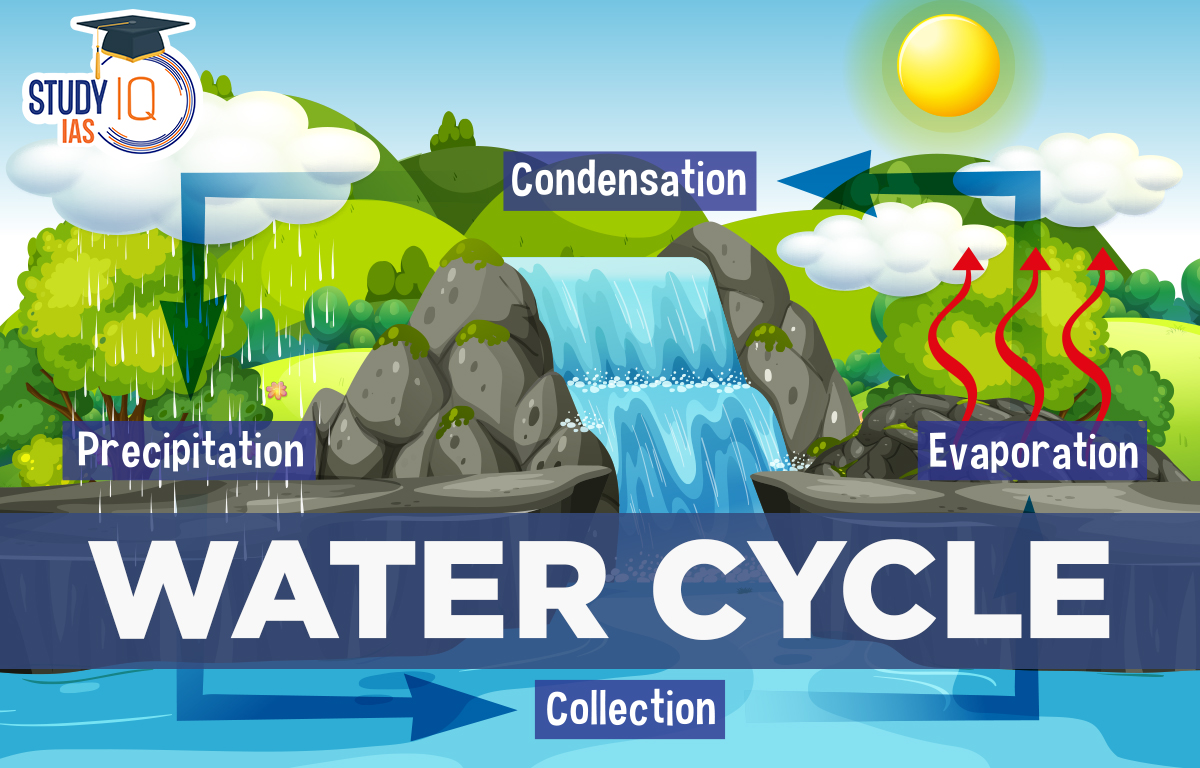Table of Contents
Water Cycle
Water is found in the air, on the ground, and underground. It can be in three forms: liquid (like water in rivers), solid (like ice), or gas (like steam). Liquid water can be fresh (like drinking water) or salty (like ocean water). Water moves from one place to another in different ways, like through rivers and clouds or in plants and animals.
The Water Cycle means the circulation of water. There is a constant and continuous circulation of water from the Earth’s surface to the atmosphere and back to the Earth’s surface. The water cycle is a combination of Evaporation and Condensation, transpiration, Precipitation, run-off, and groundwater movement.
Water on Earth can evaporate because of the Sun’s heat, from places like oceans and lakes. Plants also release water from the leave surface into the air which is called transpiration. When we put these two processes together, we call it evapotranspiration. At last, the water vapor turns into tiny droplets to form clouds. When these clouds cool over land, they release precipitation, which can be rain, sleet, or snow, bringing water back to the ground or the sea. Some of this water soaks into the ground. The water that collects below the surface trapped between layers of rock or clay which is called groundwater.
Read More: Hydrosphere
What is Water Cycle?
The hydrological cycle, or water cycle, is how water moves through the Earth in different forms: liquid, solid, and gas. It connects land, oceans, underground, and living things, making it vital for the hydrosphere.
The cycle has five main steps: evaporation, transpiration, condensation, precipitation, and runoff. While the total amount of water remains mostly constant, its distribution changes over time.
Water is found in the atmosphere, oceans, lakes, rivers, glaciers, soil, snow, and underground. It moves between these areas through processes like evaporation, condensation, precipitation, runoff, and infiltration.
Read More: Climate of India
Water Cycle Stages
Evaporation, transpiration, condensation, precipitation, and runoff are the fundamental five phases of the water cycle.
1. Evaporation
Evaporation is when a liquid turns into a gas. Water is the main concern in weather. For evaporation to happen, energy is needed, which can come from the sun, the ground, the air, or even people. We all experience evaporation. When we get hot, our bodies sweat, releasing water on our skin. This water evaporates using body heat, helping us cool down. It’s similar to the feeling you get after a shower or swimming.
2. Transpiration
Transpiration is when water evaporates from plants through small openings called stomata, which are found on the underside of leaves. Most of this water loss is influenced by the humidity in the air and how wet the soil is. Plants only use about 1% of the water they lose through transpiration for their growth the rest, about 99.9%, goes into the atmosphere.
Read More: Types of Clouds
3. Condensation
Condensation is the process where water vapor in the air turns into liquid. This can create clouds or dew. For condensation to happen, the air temperature must be lower than the dew point, which is the temperature at which dew forms. When the air cools to this point, it becomes saturated, and any further cooling causes water vapor to condense. Fog appears when the air temperature and dew point are the same. Condensation is the opposite of evaporation. It releases extra heat because water vapor has more energy than liquid water. This heat release can help form hurricanes.
4. Precipitation
Tiny particles in the air help create precipitation when they collide and stick together, becoming too heavy for the air to hold. This can result in rain, hail, sleet, or snow. Precipitation is the main source of fresh water on Earth. On average, the Earth gets about 38.5 inches (980 mm) of precipitation each year, both on land and in the oceans.
5. Runoff
Runoff happens when there is a lot of rain and the ground can not absorb any more water. This water flows into rivers and lakes. Most of this water goes back to the oceans and some of it evaporates into the air. If runoff only goes into a lake with no way out, the water can only leave by evaporating. As it evaporates, salts and pollutants are left behind, making the lake salty, like the Dead Sea or the Great Salt Lake. This evaporation restarts the water cycle.
Read More: Structure of the Atmosphere
Water Cycle Significance
- Helps keep temperatures from rising too much due to the greenhouse effect.
- Without its cooling effect, Earth’s temperature would significantly increase.
- Every living thing on Earth depends on it.
- Helps clean the air
- Water vapor sticks to dust particles, aiding in rain formation.
- In polluted cities, raindrops capture gases and contaminants, raindrops can also pick up tiny organisms like bacteria and leftover materials from factories.
Read More: Air Masses
Water Cycle UPSC
Water moves from the earth to the atmosphere and again back to the earth, completing the water cycle, which is a natural phenomenon. The water cycle involves a number of intricate processes, but it is responsible for replenishing our freshwater supplies, including rivers, lakes, and the groundwater table. The rain that the water cycle brings is also essential for plant growth, temperature regulation, and irrigation in agriculture. You will learn about the Water Cycle (Hydrologic) in this article, which will help you with the Geography and Environment syllabus preparation for the UPSC Civil Service Exam.


 El Nino and La Nina and its Impact on In...
El Nino and La Nina and its Impact on In...
 Manganese Ore, Uses, Properties, Importa...
Manganese Ore, Uses, Properties, Importa...
 Faraizi Movement, History, Founder, Begi...
Faraizi Movement, History, Founder, Begi...




















